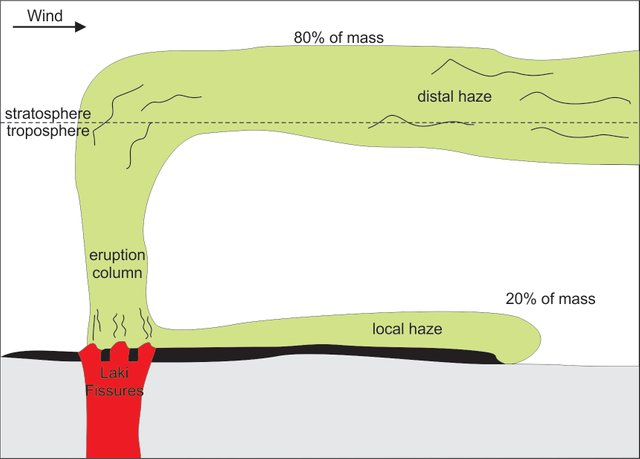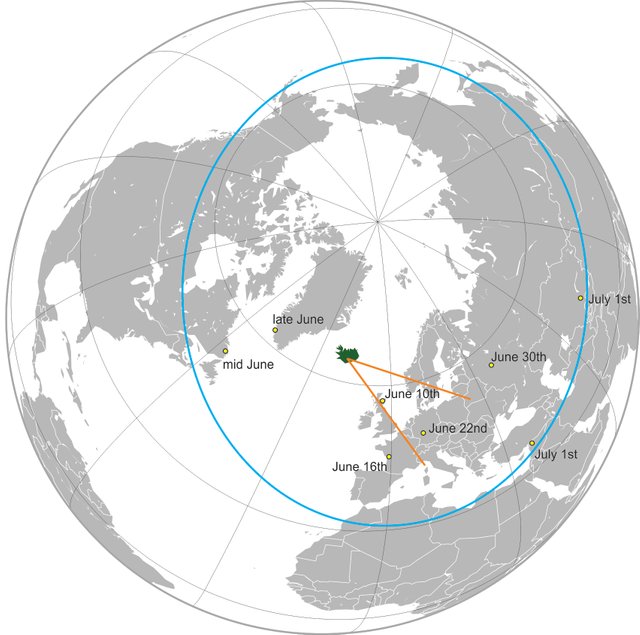Geology of Iceland - Part 9: The environmental impact of the Skaftár Fires
Introduction
During history, short-lived explosive volcanic eruptions have had small to moderate impacts on climate. This also goes for moderate to large basaltic flood lava eruptions.
Currently, Iceland is the only volcanic region on the planet, where eruptions of this type and scale repeatedly occur. The 1783-1784 Laki eruption is the best documented case for the atmospheric effects of this type of eruption. This type of eruption releases large amounts of sulphur into the atmosphere.
Flood basalt eruptions have relatively low eruption columns in comparison to other eruption types. At Laki they stayed below 15 km. This means that pyroclastic material and gases were only transported into the upper troposphere and lower stratosphere. The issue with basaltic flood basalt eruptions is that they are long lasting and therefore replenish atmospheric aerosol concentrations over a long time.
The Laki eruption produced a volcanic haze (dry fog) that hung over the North Atlantic, Europe, North Africa and Asia for many months. It had a huge impact on the environment, ranging from immediate effects to long lasting climatic pertubations.
In Europe, the year 1783 was referred to as “Annus Mirabilis” (The Year of Awe). The most astonishing and influencing phenomenon during that year was the occurrence of a widespread sulphuric aerosol cloud. This cloud has gotten various names by various countries, but in Iceland it is simply referred to as móða (haze). In Iceland, the connection between the eruption and the atmospheric changes was evident immediately. In Europe, the French naturalist M. Mourgue de Montredon was the first to connect the dry fog in Europe to volcanic activity in Iceland.
Spread of the Laki haze
Material released into the atmosphere
The estimated amounts of material that have been released into the atmosphere have been estimated to lie around 380 Mt. Of this material, the majority was water vapor (235 Mt) and SO2 (122 Mt). The rest were minor amounts of Cl and F.
Nearly all of this material was released during the first 5 months of the eruption and 80% of the gases were carried into the lower stratosphere, whereas the remaining 20% spread at low altitudes over Iceland. The amount of SO2 released was enough to form over 200 Mt of sulphuric acid aerosols.
It is reasonable to assume that all SO2 was converted into aerosols, given that the amount of magmatic water vapor that got released during the eruption was already nearly enough for a full conversation. In addition with the water already dispersed in the atmosphere, there was more than enough water available.
All of this material got fed into the polar jet stream, form where it started it journey to more distant places. The majority of the haze (aerosol cloud) spread over the Northern Hemisphere from June to October 1783.

Schematic illustration showing the degassing of the Laki eruption.
Inspired by Thordarson et al. (1996).
Timeline of the spreading haze
In the first week, the initial atmospheric impact of the Laki eruption were localized on the areas south and southeast of the fissure, where sulphuric haze, ash fall, and acid rain precipitated. The haze caused the Sun to appear blood red on the sky, significantly reducing its heat.
On the Faroe Islands and the northern tip of Scotland, acid rain began on June 10th. The haze wandered on and was first noticed in western and southern Europe between June 16th and June 19th. The haze increased widely over western and central Europe between June 22nd and June 24th. By June 26th the thick dry fog covered almost all of Europe and reached Moscow on June 30th. The haze reached Syria in late June and moved on to cover the sky above central Asia. At this point the material had travelled over 7000 km from its source. Greenland and the Atlantic region between Canada and Portugal felt the impact of the haze in late June. At last the haze occurred over Alaska and China.
This shows that the sulphuric aerosol cloud covered the Northern Hemisphere from ~35° N all the way to the North Pole.
The haze wandering in the lower troposphere over Europe, disappeared in late fall of 1783. The material in the upper troposphere and lower stratosphere lasted longer and well into the winter of 1783-1784.

Map of the northern hemisphere (Iceland highlighted in green) showing extent of the Laki eruption air pollution. Occurrence of Laki haze is shown by the blue line. The orange lines represent the area, where distal ash fall was noted. Yellow dots show individual dates of first haze occurrence.
The original form of the base map is from Ninrouter, published on commons.wikimedia.org. Complete areal extend and dates are from Thordarson and Self (2003) and the observed ash falls are from Thordarson and Self (1993).
Height and travel speed
The total thickness of the haze is not exactly known. Historical reports mention strong dimming or total extinction of celestial bodies above the horizon. For this to occur, the cloud must have been quite thick. To have the visual effects mentioned, the cloud needs to be at least 5 km high, but could have extended up to 16 km, corresponding with the maximum fountaining height.
The eastward travel speed of material from the Laki fissure via the jet stream was quite high as well (as can be seen in the timeline). Following a single straight path, clouds after each eruption, could have arrived over Europe after just 16 hours. Following the more maendering flow of the jet stream, the total travel time would be around 48 hours.
Interestingly, the first occurrence of haze and a red sun were only reported 1-3 weeks after the first eruption. This delay is best explained by the time it takes to converst SO2 to H2SO4.
Volcanic air pollution from Laki and environmental effects
Iceland
The volcanic haze and fine ash, which fell over all of Iceland, seriously affected vegetation, animals, and people. The majority of acid rainfall occurred over the areas closes to Laki. The rain was so severe, that raindrops burned holes in dock leaves and caused wounds on the skin of animals and humans, who got exposed to it.
The haze that swept over the island killed most of the birch trees, shrubs and mosses. Everywhere, the grass in cultivated fields withered down to the roots. In humans it caused weakness, shortness of breath, and throbbing of the heart. For the grazing livestock the effects were more severe, where the haze could lead to lethal sickness.
The sickness, related to the volcanic pollution, was most noticeable between the late summer and early winter of 1783. To the southeast of the fissure, the Earth got covered in ash with high abundance of Pele’s hair. There, sickness was noticed almost immediately. Mass deaths are reported only 8 to 14 days after the first eruption.
Island-wide, more than 60% of the grazing livestock died in less than a year. This lead to a famine lasting until 1786, and in Iceland it is known as the Haze Famine. This famine caused the death of 20% of the population of Iceland (at that time roughly 50,000 people).
Europe
In western and northern Europe the haze was often identified to have a sulfurous smell. Wet and dry deposition of sulfuric acid caused considerable damage to vegetation. The haze caused sickness in humans and withering of vegetation in Norway, Denmark and Sweden, which in conjunction with long lasting drought resulted in failure of the summer harvest. In England it caused damage to vegetation due to acid precipitation. In Holland troublesome headaches, respiratory difficulties and asthma attacks were attributed to the volcanic air pollution. The trees and plants lost their green color and the ground was covered with falling leaves. Similar descriptions are found in sources from Germany and France. The following winter was exceptionally cold in all of Europe. Interestingly, during the summer, higher than usual temperatures occurred in Europe.
About 85% of the haze mass was removed from the atmosphere via acid precipitation in the summer and fall of 1783. This amount is equal to deposition of ~1000 kg of sulfuric acid per km2 over a period of 5 months. The distribution was not uniform and the regions closest to the source were affected more than those further away.
North America
The Laki haze reached China on the prevailing westerlies by July 1st. The haze could have reached Alaska and North America shortly thereafter although search of historical documents for North America mention no observations of unusual haze. Studies on tree rings in Alaska and western Canada show anomalously cold summer temperatures, 4-5 °C below the average mean.
Here, after the Laki eruption, Russian sailers reported a population decrease on the Alaskan coast. Oral reports from that area stated, they left their villages after a famine. James Cook’s voyage in 1778 reported the same areas as inhabited. Oral traditions of the Inuit speak about an extremely cold summer that killed the majority of the native population of Alaska. These traditions tell of a sudden change in weather, where a normal summer turned into cold northerly winds with by snowstorms. The cold froze the waters once again and warm weather did not return until the spring of the following year. Frozen ground, rivers, and lakes would interfere with growth and collection of plant foods and access to freshwater fishery resources. The lack of plant life also caused starvation of most of the herbivore game, especially caribou, one of the main food sources.
Although not as severe, and not correlated to any deaths, winter in the rest of North America was extremely cold. Record negative temperatures were measured in Philadelphia and the harbours of New York and Baltimore froze over. The cold continued south, where even the Mississippi River at New Orleans froze slightly, creating ice blocks that traveled down the stream and were observed in the Gulf of Mexico.
Conclusion (Part 1 and 2)
The Laki eruption represents the largest outpour of lava in recorded history. Along the 27 km long fissures, the lava flowed south along the beds of the Skaftá and Hverfisfljót rivers. The lava caused damage to the settlements lying on the planes to the south, but more severely, ash falls and acid rain damaged vegetation and livestock all over Iceland. The damage was so severe, that in Iceland 20% of the population dies as the cause of a large famine. The gases that were injected into the atmosphere by the eruption traveled great distances and over time covered the complete northern part of the globe. Sulphuric fog caused damage all across Europe and screening of the suns light caused unusual cold temperatures during the following winter. The cold winter is reported all over the northern hemisphere and in Alaska it caused the death of the majority of Intuits, who could not prevail during the harsh conditions.
Previous posts
Geology of Iceland - Part 1: Introduction
Geology of Iceland - Part 2: The Iceland hotspot
Geology of Iceland - Part 3: an island being ripping apart
Geology of Iceland - Part 4: volcanic Systems
Geology of Iceland - Part 5: Magmas and Rocks
Geology of Iceland - Part 6: Volcano types
Geology of Iceland - Part 7: Eruption styles
Geology of Iceland - Part 8: Skaftáreldar | Skaftár Fires
References
- Jacoby, G.C., Workman, K.W., D’Arrigo, R.D. (1999). Laki eruption of 1783, tree rings, and disaster for northwest Alaska Inuit. Quaternary Science Reviews 18, 1365-1371.
- Oquilluk, W. A. (1973). People of Kauwerak: Legends of the Northern Eskimo. The third disaster (Ch. 5).
Stothers, R. B. (1996). The great dry fog of 1783. Climatic Change 32, 79-89. - Thordarson, T. and Self, S. (1993). The Laki (Skaftár Fires) and Grímsvötn eruptions in 1783–1785. Bulletin of Volcanology 55, 233–263.
- Thordarson, T. and Self, S. (1993). Atmospheric and environmental effects of the 1783-1784 Laki eruption: A review and reassessment. Journal of geophysical research 108.
- Thordarson, T., S. Self, N. Oskarsson, and T. Hulsebosch, Sulfur, chlorine, and fluorine degassing and atmospheric loading by the 1783 – 1784 AD Laki (Skafta´r Fires) eruption in Iceland, Bull. Volcanol., 58, 205 – 225.
- Thordarson, T., Larsen, D., Steinþórsson, S., Self, S. (2003). The 1783–1785 A.D. Laki-Grímsvötn eruptions II: Appraisal based on contemporary accounts. Jökull 53, 11-48.
- Zeilinga de Boer, J. and Sanders, D.T., (2002). Volcanoes in Human History: The Far-reaching Effects of Major Eruptions. Princeton University Press, 295 pp.

Wait... "4-5 °C below the average mean." from one eruption! That is amazing! How do you think the world would deal with that if a similar eruption happened now? I mean it is bound to happen again right?
Great post (resteemed for volcanoes). Cheers.
It is going to happen again. The Eldgjá eruption in 934 AD was even bigger than the Laki eruption. An eruption like this would probably cause immense trouble for Iceland. I am not sure how much Icelanders still depend on Livestock, but I hope that you could hide them in barns nowadays for a few months to get them out of the acid rain.
In Europe I believe it would be only an annoyance, more than a real threat. I can only imagine what kind of damage acid precipitations would do to car paint. Not sure how much trouble a record winter would bring. This years winter has been record breaking in Canada, and although it caused some trouble, I am not aware of any crazy problems that occurred (please correct me, I do not read enough news).
I think, the biggest issue nowadays will be the cancellation of air traffic due to the haze. A long lasting flight ban (5 months for Laki) could really piss some people off.
But if I want to worry about volcanoes, I'd be more inclined to look at Yellow Stone...
Thanks for the reply. I agree with you. It will happen again. Uniformitarianism is powerful. One big eruption is not a "once off". But with bigger populations, global air travel, and other considerations (i.e. power lines) it will be interesting to see how it goes.
I think I record winter would be a problem. Much agriculture exists on fringes of where things grow well. Change things a bit and poof... unsustainable. But wait and see. Would be amazing to have one big eruption in the very modern age!
Great post. Yellowstone is awesome too. Any supervolcano really deserves a solid post or 5! Cheers!
Yeah, I am curious how a big eruption would play out in the modern world. But rather as a bystander, and not as a person actually living on that planet 😂
Hahaha. Yes. Would be easier from another planet or certainly cool watching it from space. But nevertheless cool. The Long valley caldera and Taupo in NZ would be two that I would love to have been able to have seen... wait until quantum research permits time travel... ;)
I wish I could visit Iceland, it's definitely on my list
I have laid parts of my personal field-trip out while writing this series. I think Iceland is currently at the top of my list. Just need to find a few travel companions to share the rental car costs.
Well if I head in that direction I will give you a shout :)
Please do :)
Congratulations! Your post has been selected as a daily Steemit truffle! It is listed on rank 18 of all contributions awarded today. You can find the TOP DAILY TRUFFLE PICKS HERE.
I upvoted your contribution because to my mind your post is at least 10 SBD worth and should receive 113 votes. It's now up to the lovely Steemit community to make this come true.
I am
TrufflePig, an Artificial Intelligence Bot that helps minnows and content curators using Machine Learning. If you are curious how I select content, you can find an explanation here!Have a nice day and sincerely yours,

TrufflePigThat's a first. How cool 😃😎
This post has been voted on by the steemstem curation team and voting trail.
There is more to SteemSTEM than just writing posts, check here for some more tips on being a community member. You can also join our discord here to get to know the rest of the community!
Congratulations @sooflauschig! You have completed the following achievement on Steemit and have been rewarded with new badge(s) :
Click on the badge to view your Board of Honor.
If you no longer want to receive notifications, reply to this comment with the word
STOPDo not miss the last post from @steemitboard:
SteemitBoard and the Veterans on Steemit - The First Community Badge.